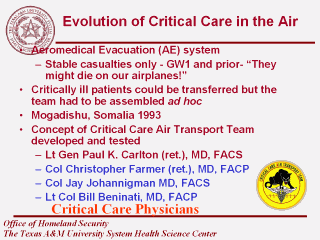 |
The Air Force has had the role of aeromedical
evacuation in peacetime and war and is capable of moving an incredible
number of stable patients. However as recently as Desert Storm the AE system
lacked the ability to move critically ill patients. Essentially they could
be moved but an ad hoc team had to be assembled and equipment gathered.
During the events chronicled in Black Hawk Down in Mogadishu Somalia this
would prove to be a major issue. Aeromedical evacuation was requested for a
marine who sustained a shark bite and was in critical condition prior to the
beginning of the major operation. The Air Force sent an aircraft with a
standard crew(flight nurse and technician) but the patient required
additional medical attendants due to his critical condition. The medical
attendants required to fly with the patient to Germany were a surgeon and
respiratory technician from the Army’s 46th CSH. In a subsequent 48 hours
the remaining surgeons would be inundated with casualties and perform 34.
Missing 1/3 of their surgeons was clearly less than ideal. But the lesson
was learned and the individuals I have listed here can be considered the
originators and champions of the Critical Care Air Transport Teams that we
have today. |
